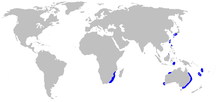| Smallfin gulper shark | |
|---|---|

| |
| Scientific classification | |
| Domain: | Eukaryota |
| Kingdom: | Animalia |
| Phylum: | Chordata |
| Class: | Chondrichthyes |
| Subclass: | Elasmobranchii |
| Subdivision: | Selachimorpha |
| Order: | Squaliformes |
| Family: | Centrophoridae |
| Genus: | Centrophorus |
| Species: | C. moluccensis
|
| Binomial name | |
| Centrophorus moluccensis (Bleeker, 1860)
| |

| |
| Range of smallfin gulper shark (in blue) | |
The smallfin gulper shark or endeavour dogfish,[1] (Centrophorus moluccensis) is a medium-sized deepwater dogfish in the family Centrophoridae.
Physical characteristics
The smallfin gulper has no anal fin, two dorsal fins with spines, long free rear tips on pectoral fins, and a deeply notched caudal fin. Its maximum length is 98 cm (39 in).[2]
Distribution
The smallfin gulper is found in the western Indian Ocean off South Africa and Mozambique, and the western Pacific off Honshū, Japan, Indonesia, New Hebrides, New Caledonia, and Australia.[3] The Australian populations are regarded as near threatened in the Eastern[4] and least concern in the Western[5] populations.
Habits and habitat
Smallfin gulpers are common deepwater sharks. They live near the bottom between 130 m (430 ft) and 820 m (2,690 ft). They are ovoviviparous and have two pups per litter. Their diets are primarily bony fish, but also other sharks, molluscs, crustaceans, and even tunicates are consumed.[6]
References
- ^ a b Finucci, B.; Bineesh, K.K.; Cheok, J.; Cotton, C.F.; Dharmadi, Kulka, D.W.; Neat, F.C.; Pacoureau, N.; Rigby, C.L.; Tanaka, S.; Walker, T.I. (2020). "Centrophorus moluccensis". IUCN Red List of Threatened Species. 2020: e.T42838A68614328. doi:10.2305/IUCN.UK.2020-3.RLTS.T42838A68614328.en. Retrieved 19 November 2021.
{{cite journal}}: CS1 maint: multiple names: authors list (link) - ^ "Centrophorus moluccensis". Integrated Taxonomic Information System. Retrieved 5 February 2006.
- ^ Froese, Rainer; Pauly, Daniel (eds.) (2006). "Centrophorus moluccensis" in FishBase. February 2006 version.
- ^ Graham, K. (2013). "Centrophorus moluccensis (Eastern Australian subpopulation)". IUCN Red List of Threatened Species. 2013: e.T16727327A16727414. doi:10.2305/IUCN.UK.2013-1.RLTS.T16727327A16727414.en. Retrieved 23 August 2023.
- ^ Graham, K. (2013). "Centrophorus moluccensis (Western Australian subpopulation)". IUCN Red List of Threatened Species. 2013: e.T16727330A16727428. doi:10.2305/IUCN.UK.2013-1.RLTS.T16727330A16727428.en. Retrieved 23 August 2023.
- ^ FAO Species Catalogue Volume 4 Parts 1 and 2 Sharks of the World

